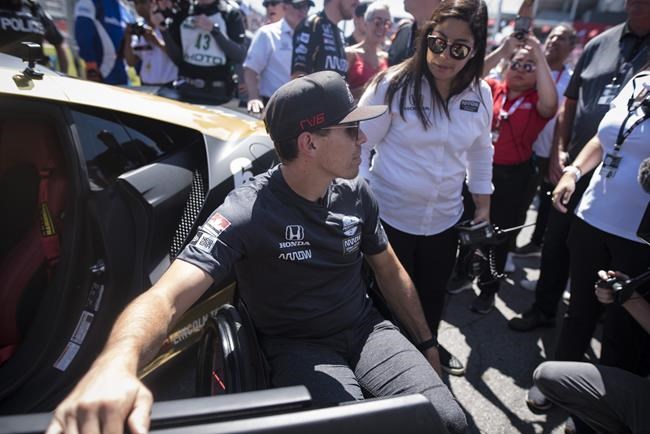Robert Wickens moving up to IMSA GTD series in 2025 thanks to new Bosch hand controls
By John Chidley-Hill, The Canadian Press on November 27, 2024.
 Injured driver Robert Wickens, of Canada, is photographed before leading the parade lap in a car fitted with hand controls before the 2019 Honda Indy Toronto race, in Toronto, Sunday July 14, 2019. THE CANADIAN PRESS/ Tijana Martin
Injured driver Robert Wickens, of Canada, is photographed before leading the parade lap in a car fitted with hand controls before the 2019 Honda Indy Toronto race, in Toronto, Sunday July 14, 2019. THE CANADIAN PRESS/ Tijana MartinIt’s been a long road back to the highest levels of motorsport for Canadian driver Robert Wickens.
Six years after he was paralyzed in a violent wreck, Wickens will again be behind the wheel against some of the best drivers in North America.
Wickens, from Guelph, Ont., was named the newest driver for DXDT Racing earlier this week, moving the 35-year-old up to IMSA GTD competition for 2025, the highest class on the WeatherTech SportsCar Championship series. His promotion was made possible by a new hand control braking system created by Bosch Electronics, with help from GM Motorsports and Corvette Racing/Pratt Miller.
“It’s not going to be easy but I wanted to get to the highest levels of motorsport again because, frankly, that’s where I was when I was injured,” said Wickens, who crashed at Pocono Raceway in 2018 during IndyCar’s ABC Supply 500. “But not only that, I want to prove to myself and other generations of people with disabilities that you can really do anything.
“Maybe you’re having a hard time getting back to your place of work after a life-altering accident and – whatever your discipline, it doesn’t even have to be athletics – but I know it’s possible as long as you align yourself with a strong support system.”
For Wickens, that’s been his wife Karli Wickens, his family and, in his professional life, organizations like Bosch and GM.
Wickens’s crash left him with a thoracic spinal fracture, a neck fracture, tibia and fibula fractures to both legs, fractures in both hands, a fractured right forearm, a fractured elbow, four fractured ribs, a pulmonary contusion, and an indeterminate spinal injury that combined to make him a paraplegic.
As he has slowly recovered some movement in his legs, Wickens has eased back into motor racing.
He drove the parade lap of the 2019 Honda Indy Toronto, competed in the IndyCar iRacing Challenge during the early days of the COVID-19 pandemic, and then in January 2022 it was announced he would drive in the Michelin Pilot Challenge for Bryan Herta Autosport.
He and co-driver Mark Wilkins won twice in the Michelin Pilot Challenge’s TCR category with three podiums in 2022. In 2023 the pairing didn’t win, but they reached the podium seven times to earn the TCR championship.
All of Wickens’s post-accident cars have been fitted with hand controls.
Those conventional systems rely on paddles around the steering wheel that activate pneumatics that then press the foot pedals.
Hand controls like that are acceptable for regular road vehicles and even lower levels of motorsports but in the highest classes, like IMSA GTD where cars top out at more than 280 kilometres, the lag between the driver toggling the paddle and the car responding is unacceptably slow.
That’s where the Bosch electronic system comes in, with the controls linked directly to the car’s braking system, removing the pneumatics as an intermediary.
“When you hit the brakes to slow the car down for each corner that was always a big challenge for me where (with) the Bosch electronic system, the latency is milliseconds not tenths of a second,” said Wickens. “It’s basically as accurate as I would be if I was an able-bodied driver wanting to apply the brake.
“Honestly, it’s just better in every facet imaginable. It’s just been a true blessing.”
Advances in physical rehabilitation from spinal cord injuries as well as the ongoing development of vehicle technology has made Wickens’s return to competitive motorsport possible.
“I’m very fortunate in the timing of my paralysis and my career,” Wickens said Wednesday from Tampa, Fla. “If this was even a decade ago we’d be having a very different conversation today.”
The IMSA WeatherTech SportsCar Championship has four classes of vehicles: two sports prototype categories and two grand tourer classes. GTD is considered the highest of the four classes because each team must have at least a silver or bronze driver and more than one platinum-rated driver on a team is prohibited.
“I want to win,” said Wickens. “I think the big thing for me on this journey back was I wanted to race again because I truly felt like I could still win.
“I want to raise awareness for spinal cord injury and disability, not by just being a participant, but by being the guy. I want to win races, fight for podiums, win championships, every time I’m sitting in the car.”
Wickens said he won’t just be a role model for people living with paralysis or other mobility disabilities, but the technology his car will employ in 2025 will likely become commercially available for use in road vehicles.
“Motorsports and the automotive racing industry were founded to be a proving ground for everyday automotive vehicles,” he said. “From there you make road cars and road safety better.
“Hopefully we can provide the technology and have regularly available components that can make any race car accessible for anyone that needs hand controls or any other form of disability.”
This report by The Canadian Press was first published Nov. 27, 2024.
Follow jchidleyhill.bsky.social on Bluesky.
27-26


